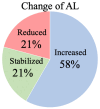Axial Length Stabilization or Reduction in over 40% of Patients Wearing Extended Depth-of-Focus Contact Lenses
- PMID: 40095887
- PMCID: PMC11901261
- DOI: 10.3390/jcm14051750
Axial Length Stabilization or Reduction in over 40% of Patients Wearing Extended Depth-of-Focus Contact Lenses
Abstract
Background/Objectives: Preceding studies have reported the efficacy of multifocal contact lenses (MFCLs) in slowing myopia progression. Recently, a novel type of MFCL, i.e., extended depth-of-focus (EDOF) contact lens (CL), was designed. Here, we retrospectively investigated myopia progression associated with EDOF CL wear. Methods: Twenty-four consecutive myopic children (24 eyes; mean age, 13.9 years) received EDOF CLs to control myopia progression and participated in the study. We measured the axial length (AL), spherical equivalent (SE), and choroidal thickness (CT) at baseline and after 1 year of lens wear and compared the changes. Results: The mean baseline AL, SE, and CT were, respectively, 26.31 mm, -6.38 diopter (D), and 235 μm, and at 1 year 26.40 mm (p = 0.03), -6.61 D (p = 0.05), and 244 μm (p = 0.18). The AL decreased in 20.8% of cases (≧-0.05 mm/year), whereas 20.8% and 58.4% of cases had stabilization of the AL or an increased AL (≧+0.05 mm/year), respectively. The patients with a decreased AL engaged in a mean outdoor activity time of 200.6 min/day, the patients with an increased AL (≧+0.05 mm/year) engaged in a mean outdoor activity time of 126.7 min/day. The change in the AL was correlated significantly with the change in the CT (β = -0.46, p < 0.05), and 80% of patients with a shortened AL had increased CT (≧+20 μm/year). Conclusions: Our data showed that the AL stabilized or decreased in over 40% of myopic patients wearing EDOF CLs.
Keywords: axial length; choroidal thickness; extended depth-of-focus lenses; myopia; spherical equivalent.
Conflict of interest statement
H.T. has received Specified Contributions from SEED Co., Ltd. (Tokyo, Japan). The other authors declare no conflicts of interest. The funders had no role in the design of the study; in the collection, analyses, or interpretation of data; in the writing of the manuscript; or in the decision to publish the results.
Figures


Similar articles
-
Myopia control with novel central and peripheral plus contact lenses and extended depth of focus contact lenses: 2 year results from a randomised clinical trial.Ophthalmic Physiol Opt. 2019 Jul;39(4):294-307. doi: 10.1111/opo.12621. Epub 2019 Jun 10. Ophthalmic Physiol Opt. 2019. PMID: 31180155 Free PMC article. Clinical Trial.
-
Three-Year Change in Subfoveal Choroidal Thickness and Area With Multifocal Contact Lens Wear in the Bifocal Lenses in Nearsighted Kids (BLINK) Study.Invest Ophthalmol Vis Sci. 2025 May 1;66(5):5. doi: 10.1167/iovs.66.5.5. Invest Ophthalmol Vis Sci. 2025. PMID: 40314656 Free PMC article. Clinical Trial.
-
Interventions to slow progression of myopia in children.Cochrane Database Syst Rev. 2020 Jan 13;1(1):CD004916. doi: 10.1002/14651858.CD004916.pub4. Cochrane Database Syst Rev. 2020. PMID: 31930781 Free PMC article.
-
Slowing Down Myopia Progression with Contact Lenses - Everyday Cases from the Clinic.Klin Monbl Augenheilkd. 2021 Apr;238(4):437-442. doi: 10.1055/a-1440-0642. Epub 2021 Apr 30. Klin Monbl Augenheilkd. 2021. PMID: 33930921 English.
-
Efficacy of contact lenses for myopia control: Insights from a randomised, contralateral study design.Ophthalmic Physiol Opt. 2022 Nov;42(6):1253-1263. doi: 10.1111/opo.13042. Epub 2022 Aug 25. Ophthalmic Physiol Opt. 2022. PMID: 36006761 Free PMC article. Clinical Trial.
References
-
- Yotsukura E., Torii H., Inokuchi M., Tokumura M., Uchino M., Nakamura K., Hyodo M., Mori K., Jiang X., Ikeda S.I., et al. Current Prevalence of Myopia and Association of Myopia with Environmental Factors among Schoolchildren in Japan. JAMA Ophthalmol. 2019;137:1233–1239. doi: 10.1001/jamaophthalmol.2019.3103. - DOI - PMC - PubMed
-
- Yotsukura E., Torii H., Mori K., Ogawa M., Hanyuda A., Negishi K., Kurihara T., Tsubota K. Slowing of Greater Axial Length Elongation Stemming from the Coronavirus Disease 2019 Pandemic with Increasing Time Outdoors: The Tokyo Myopia Study. Ophthalmol. Sci. 2024;4:100491. doi: 10.1016/j.xops.2024.100491. - DOI - PMC - PubMed
Grants and funding
LinkOut - more resources
Full Text Sources

